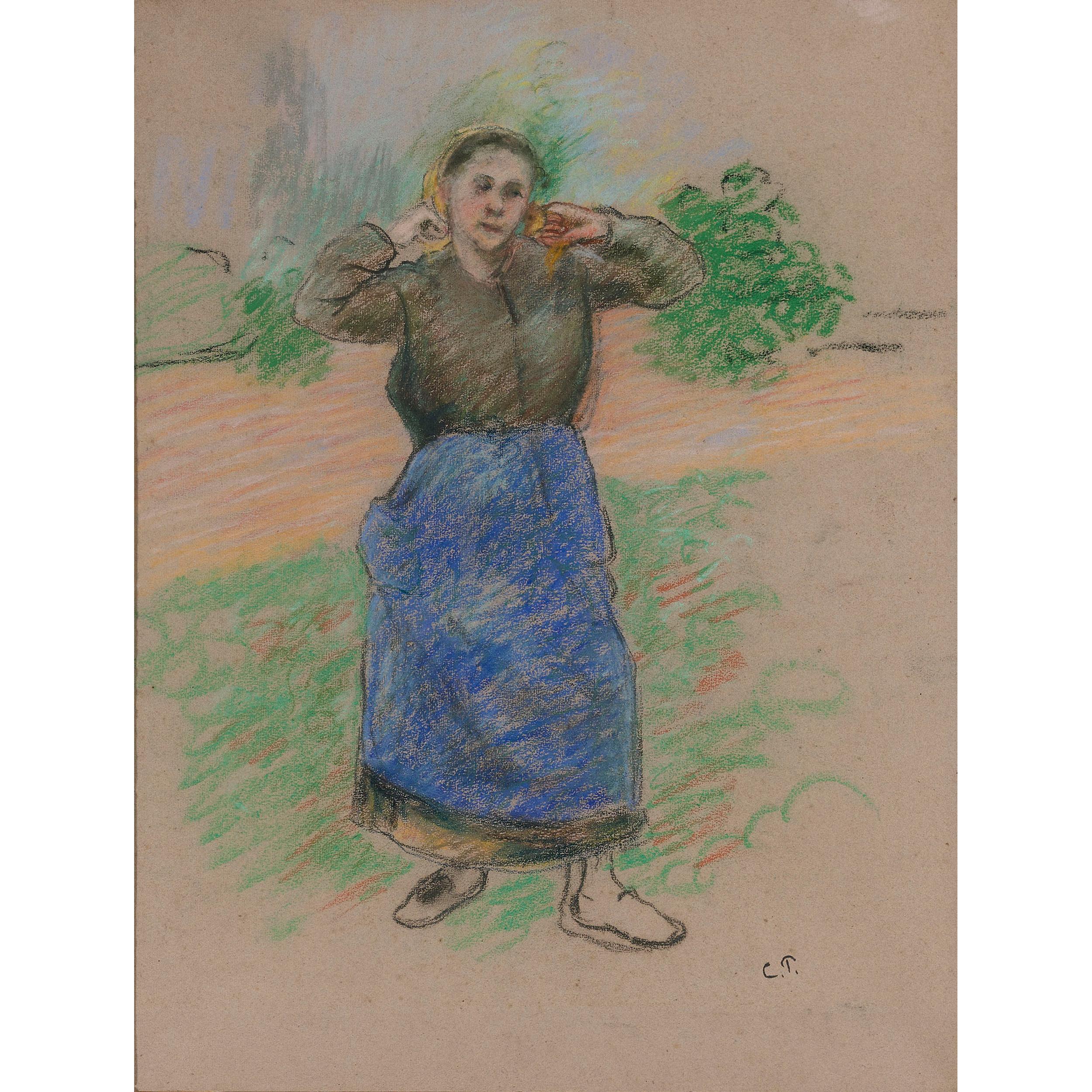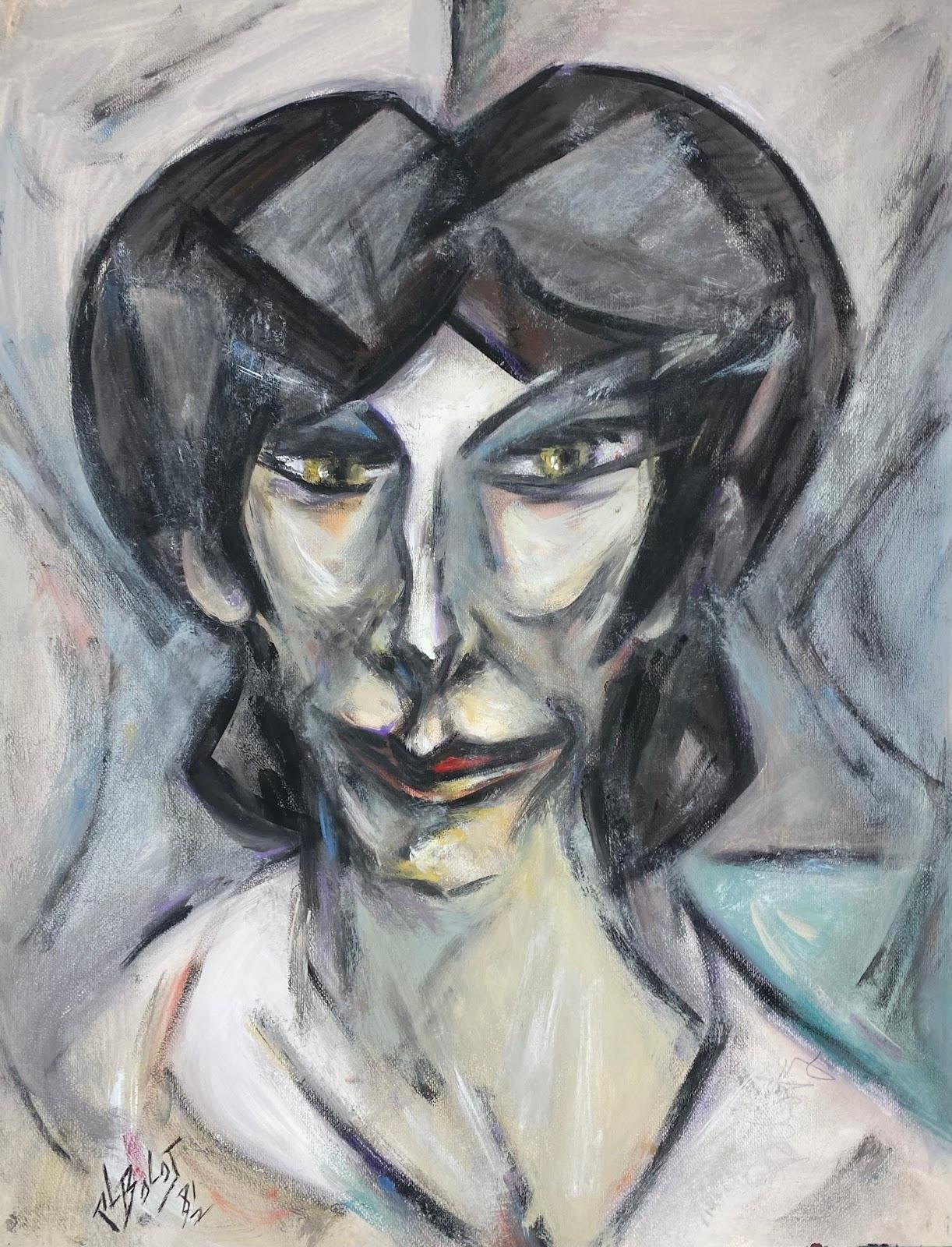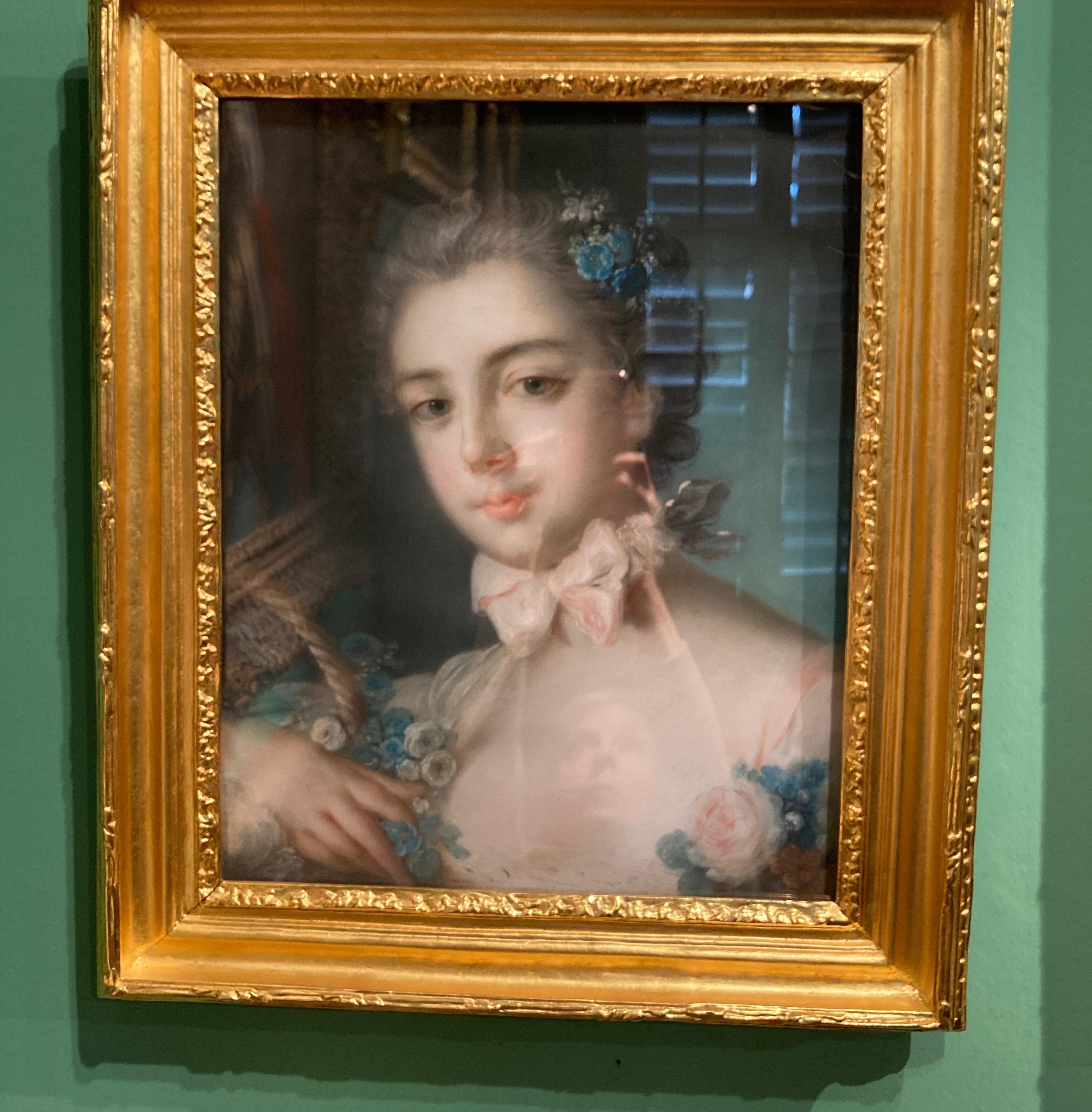Items Similar to The Breton Girl, Mid Century Drawing with Watercolour
Want more images or videos?
Request additional images or videos from the seller
1 of 15
Renée BéjaThe Breton Girl, Mid Century Drawing with Watercolour1930s
1930s
About the Item
A French drawing and watercolour portrait of a Breton Girl by Renée Béja noted pupil of Fernand leger. The work is signed on the right margin and presented in a gilt frame with a fine cut card mount.
A wonderful character portrait of a girl in traditional Breton costume and head dress. Beja has completed a pencil drawing and then used washes, watercolour and gouache to give the composition life. Lifelike flesh tones and the blue of the subjects eyes give the whole a charming intimacy.
Renée Anne Béja was a French painter and theatre decorator of Greek origin born in Thessaloniki (Ottoman Empire, today in Greece) on July 4, 1905
Renée Béja was still a young child when the family moved to Solliès-Pont in France, where her father worked as a flour miller at the Crédit Agricole.
In the 1930s, Renée Béja was a pupil of Fernand Léger. Between 1935 and 1938, she exhibited at the Salon des Tuileries, presenting mainly Views of the Périgord, she also participated in 1938 in the Salon d'Automne and the Salon des Indépendants.
During the Second World War, Renée Béja, her husband and some of her family were saved by being hidden by Eugène Viès, executive of the SNCF in Solliès-Pont, the industrialist Étienne Arnaud and the secretary of the town hall registering them under a false name on the register of inhabitants, so as to entitle them to food tickets. A Gestapo raid, however, meant that the Béja family had to leave Solliès-Pont for Saint-Paul-Trois-Châteaux, always with the help of Eugène Viès and his wife Walda, to whom the Yad Vashem Institute has since awarded the title of Righteous Among the Nations.
Based at 41, rue Blomet in Paris, Renée Béja then also worked as a decorator for the theatre. She created the sets, costumes and masks for the play Les Choéphores by Aeschylus, performed in the great amphitheatre of the Sorbonne in June 1949, then at the Palais des Papes as part of the Avignon Festival in July 1950.
The works of René Béjà, including portraits, nudes, still lifes, landscapes of Provence, Brittany and Paris, were presented at the Salon du Gemmail in Tours, stylistically, as with her colleague Andrée Bordeaux-Le Pecq, post-cubist and abstract experiments, but also classifying it, with Germaine Lacaze, Marguerite Bermond, Geneviève Gavrel and Guillemette Morand, among the heirs of the painters of poetic reality.
Renée Béja's studio was dispersed at the Hôtel Drouot on 26 March 1996.
The Taylor Foundation has created an annual award named after Renée Béja.
- Creator:Renée Béja (1905 - 1979, French)
- Creation Year:1930s
- Dimensions:Height: 13.59 in (34.5 cm)Width: 12.01 in (30.5 cm)Depth: 0.79 in (2 cm)
- Medium:
- Movement & Style:
- Period:
- Condition:Some chipping to the frame.
- Gallery Location:Cotignac, FR
- Reference Number:Seller: LG/Beja1stDibs: LU1430212390782
About the Seller
5.0
Platinum Seller
These expertly vetted sellers are 1stDibs' most experienced sellers and are rated highest by our customers.
Established in 2000
1stDibs seller since 2020
161 sales on 1stDibs
Typical response time: <1 hour
- ShippingRetrieving quote...Ships From: Cotignac, France
- Return PolicyA return for this item may be initiated within 3 days of delivery.
More From This SellerView All
- Ex Machina, Nicaragua Solidarity CampaignLocated in Cotignac, FRA late 20th Century watercolour and pastel drawing of machines in a landscape by British artist Paul Chambers. The painting is signed bottom right and carries an exhibition label for...Category
Late 20th Century Contemporary Figurative Drawings and Watercolors
MaterialsPaper, Pastel, Watercolor, Gouache
- Suzanne, Large Mid Century Portrait Drawing by GourdonLocated in Cotignac, FRFrench, Mid Century, pastel and crayon portrait of an elegant young lady by Gourdon. Signed and dated bottom left. Trade label to the back board. Presented in period deep 'tray' frame. This seems to be an early work by the artist and hence it carries his name rather than his later more distinctive signature 'Aslan'. Alain Gordon was one of two brothers, his sibling Michel also went on to achieve notable success with his distinctive 'comic' style. Alain Gourdon...Category
Mid-20th Century Modern Portrait Drawings and Watercolors
MaterialsPencil, Paper, Crayon, Pastel, Watercolor
- French Art Deco Society Portrait, Beauty in a HatLocated in Cotignac, FRA French art deco pastel portrait by Louis-Jean Beaupuy. The work is signed and dated bottom right. Presented in carved and gilded wood frame. Beaupuy has captured all the charm and...Category
Mid-20th Century Art Deco Portrait Drawings and Watercolors
MaterialsPaper, Crayon, Pastel
- Set of Three Gouache & Watercolour Paintings of Tribal Objects on Handmade PaperBy La Roche LaffitteLocated in Cotignac, FRA set of three framed watercolour and gouache studies on handmade paper applied to Vélin d'Arches of tribal objects by French artist La Roche Laffi...Category
Late 20th Century Realist Figurative Drawings and Watercolors
MaterialsWatercolor, Gouache, Handmade Paper
- French Pastel Portrait of a Chevalier of the Order of St Louis.By (Circle of) Jean Baptiste GreuzeLocated in Cotignac, FRA fine 18th century French pastel portrait on paper of an aristocrat wearing the order of St Louis, inferring that the sitter had been in the military serving the King. The pastel is unsigned but to the the back is a piece of the original backing paper with a notation to the Baronne de Minck. The paper has been backed with a type of vellum, It is presented in a plain gilt wood frame on a period stretcher under 18th century glass. The artist has used the pastel to create a wonderful soft velvety texture so characteristic of this medium which became so popular for portraits in the 18th century. A charming rendition of a typical 18th century nobleman...Category
18th Century Romantic Portrait Drawings and Watercolors
MaterialsPaper, Pastel
- French 18th Century Pastel PortraitLocated in Cotignac, FRLate 18th Century French pastel portrait on paper of a young lady in period dress in a 'feigned oval'. In gilt wood frame presented under glass. Very much of its period and similar ...Category
Late 18th Century French School Portrait Drawings and Watercolors
MaterialsPastel, Paper, Crayon
You May Also Like
- Rare Modernist Hungarian Rabbi Pastel Drawing Gouache Painting Judaica Art DecoBy Hugó ScheiberLocated in Surfside, FLRabbi in the synagogue at prayer wearing tallit and tefillin. Hugó Scheiber (born 29 September 1873 in Budapest – died there 7 March 1950) was a Hungarian modernist painter. Hugo Scheiber was brought from Budapest to Vienna at the age of eight where his father worked as a sign painter for the Prater Theater. At fifteen, he returned with his family to Budapest and began working during the day to help support them and attending painting classes at the School of Design in the evening, where Henrik Papp was one of his teachers. He completed his studies in 1900. His work was at first in a post-Impressionistic style but from 1910 onward showed his increasing interest in German Expressionism and Futurism. This made it of little interest to the conservative Hungarian art establishment. However, in 1915 he met the great Italian avant-gardist Filippo Tommaso Marinetti and the two painters became close friends. Marinetti invited him to join the Futurist Movement. The uniquely modernist style that he developed was, however, closer to German Expressionism than to Futurism and eventually drifted toward an international art deco manner similar to Erté's. In 1919, he and his friend Béla Kádar held an exhibition at the Hevesy Salon in Vienna. It was a great success and at last caused the Budapest Art Museum to acquire some of Scheiber's drawings. Encouraged, Scheiber came back to live in Vienna in 1920. A turning point in Scheiber's career came a year later, when Herwarth Walden, founder of Germany's leading avant-garde periodical, Der Sturm, and of the Sturm Gallery in Berlin, became interested in Scheiber's work. Scheiber moved to Berlin in 1922, and his paintings soon appeared regularly in Walden's magazine and elsewhere. Exhibitions of his work followed in London, Rome, La Paz, and New York. Scheiber's move to Germany coincided with a significant exodus of Hungarian artists to Berlin, including Laszlo Moholy-Nagy and Sandor Bortnyik. There had been a major split in ideology among the Hungarian avant-garde. The Constructivist and leader of the Hungarian avantgarde, Lajos Kassák (painted by Hugó Scheiber in 1930) believed that art should relate to all the needs of contemporary humankind. Thus he refused to compromise the purity of his style to reflect the demands of either the ruling class or socialists and communists. The other camp believed that an artist should be a figurehead for social and political change. The fall out and factions that resulted from this politicisation resulted in most of the Hungarian avant gardists leaving Vienna for Berlin. Hungarian émigrés made up one of the largest minority groups in the German capital and the influx of their painters had a significant effect on Hungarian and international art. Another turning point of Scheiber's career came in 1926, with the New York exhibition of the Société Anonyme, organized by Katherine Dreier. Scheiber and other important avant garde artists from more than twenty-three countries were represented. In 1933, Scheiber was invited by Marinetti to participate in the great meeting of the Futurists held in Rome in late April 1933, Mostra Nazionale d’Arte Futurista where he was received with great enthusiasm. Gradually, the Hungarian artists began to return home, particularly with the rise of Nazism in Germany. Kádar went back from Berlin in about 1932 and Scheiber followed in 1934. He was then at the peak of his powers and had a special flair in depicting café and cabaret life in vivid colors, sturdily abstracted forms and spontaneous brush strokes. Scheiber depicted cosmopolitan modern life using stylized shapes and expressive colors. His preferred subjects were cabaret and street scenes, jazz musicians, flappers, and a series of self-portraits (usually with a cigar). his principal media being gouache and oil. He was a member of the prestigious New Society of Artists (KUT—Képzőművészek Új Társasága)and seems to have weathered Hungary's post–World War II transition to state-communism without difficulty. He continued to be well regarded, eventually even receiving the posthumous honor of having one of his images used for a Russian Soviet postage stamp (see image above). Hugó Scheiber died in Budapest in 1950. Paintings by Hugó Scheiber form part of permanent museum collections in Budapest (Hungarian National Museum), Pecs (Jannus Pannonius Museum), Vienna, New York, Bern and elsewhere. His work has also been shown in many important exhibitions, including: "The Nell Walden Collection," Kunsthaus Zürich (1945) "Collection of the Société Anonyme," Yale University Art Gallery, New Haven, Connecticut (1950) "Hugó Scheiber: A Commemorative Exhibition," Hungarian National Museum, Budapest (1964) "Ungarische Avantgarde," Galleria del Levante, Munich (1971) "Paris-Berlin 1900-1930," Centre Georges Pompidou, Paris (1978) "L’Art en Hongrie, 1905-1920," Musée d’Art et l’Industrie, Saint-Etienne (1980) "Ungarische Avantgarde in der Weimarer Republik," Marburg (1986) "Modernizmus," Eresz & Maklary Gallery, Budapest (2006) "Hugó Scheiber & Béla Kádár," Galerie le Minotaure, Paris and Tel Aviv (2007) Hugó Scheiber's paintings continue to be regularly sold at Sotheby's, Christie's, Gillen's Arts (London), Papillon Gallery (Los Angeles) and other auction houses. He was included in the exhibition The Art Of Modern Hungary 1931 and other exhibitions along with Vilmos Novak Aba, Count Julius Batthyany, Pal Bor, Bela Buky, Denes Csanky, Istvan Csok, Bela Czobel, Peter Di Gabor, Bela Ivanyi Grunwald, Baron Ferenc Hatvany, Lipot Herman, Odon Marffy, C. Pal Molnar...Category
Early 20th Century Modern Figurative Paintings
MaterialsPaper, Charcoal, Pastel, Watercolor, Gouache
- Paysanne Nouant son Foulard (Peasant Arranging her Scarf)By Camille PissarroLocated in New Orleans, LAThis intimate work by Camille Pissarro represents a period of significance for the Impressionist master. The early 1880s was a time of great experimentation for the artist, after he spent much of the preceding decade devoted to landscape painting. Shifting focus, he embarked on a series of works in a range of media dedicated to the human figure - particularly peasant women. In watercolor, gouache, pastel, and print, Pissarro captured the rural female and the minute moments of domestic life. Depicting a peasant woman tying her scarf, Paysanne Nouant son Foulard displays the harmony of color and composition that typifies his work of the 1880s. Composed of a symphony of color and strokes of paint, the work exemplifies the plein air technique of Pissarro's best Impressionist canvases. A true master of his art, no other artist successfully chronicled rural peasant life quite like Pissarro. Counted among the most respected artists of the 19th century and widely considered the father of Impressionism, Pissarro’s works experienced a surge in interest in the early 2000s. This is reflected in Pissarro’s new auction record of over $32.1 million, set at a 2014 Sotheby’s auction in London, which far surpassed his previous record of $14.6 million. Born in St. Thomas in the Danish West Indies, Pissarro was sent to school in Paris at the age of 11, where he first displayed a talent for drawing. In 1855, having convinced his parents of his determination to pursue a career as an artist rather than work in the family shipping business, he returned to Paris where he studied at the Académie Suisse alongside Claude Monet. At the outbreak of the Franco-Prussian War in 1870, Pissarro moved to England. With Monet, he painted a series of landscapes around South-East London and studied English landscape painters in the museums. When he returned home to Louveciennes a year later, Camille discovered that all but 40 of the 1500 paintings he had left there - almost 20 years of work - had been vandalized. In 1872, Camille settled in Pontoise where he remained for the next 10 years, gathering a close circle of friends around him. Gauguin was among the many artists to visit him there and Cézanne, who lived nearby, came for long periods to work and learn. In 1874, Pissarro participated in the first Impressionist exhibition...Category
Late 19th Century Impressionist Portrait Drawings and Watercolors
MaterialsPastel, Paper
- 20th Century French Modernist Cubist Painting Broodin Portrait Dark Haired LadyLocated in Cirencester, GloucestershirePortrait by Paul-Louis Bolot (French 1918-2003) signed (dated 1981) original gouache painting on thick paper/ card unframed condition: very good and sound; the edges have a few curls...Category
20th Century Cubist Figurative Paintings
MaterialsGouache
- Art Deco Glamour illustration, Golden Age of HollywoodBy Jaro FabryLocated in Miami, FLCaption: "He proposed this morning right after the alarm clock went off." From the Estate of Charles Martignette Signed lower center unframedCategory
1940s Art Deco Portrait Drawings and Watercolors
MaterialsInk, Watercolor
- Sit woman pastel drawingBy Rafael Duran BenetLocated in Barcelona, BarcelonaRafael Duran Benet (1931-2015) - Sit woman - Pastel Drawing measurements 62x42 cm. Frame measurements 82x62 cm. Rafael Duran Benet (Terrassa, 1931 - Barcelona, 2015) is a Catalan painter...Category
1970s Post-Impressionist Portrait Drawings and Watercolors
MaterialsPastel
- Rococo Portait, French Rococo, Marie Baudouin, Daughter of Francois BoucherBy François BoucherLocated in Greven, DEPortrait of the daughter of Francois Boucher, Marie-Emilie Baudouin, holding a basket of flowers. Pastel on Parchment. The work is related to an oval portrait painting...Category
18th Century Rococo Portrait Drawings and Watercolors
MaterialsPastel




